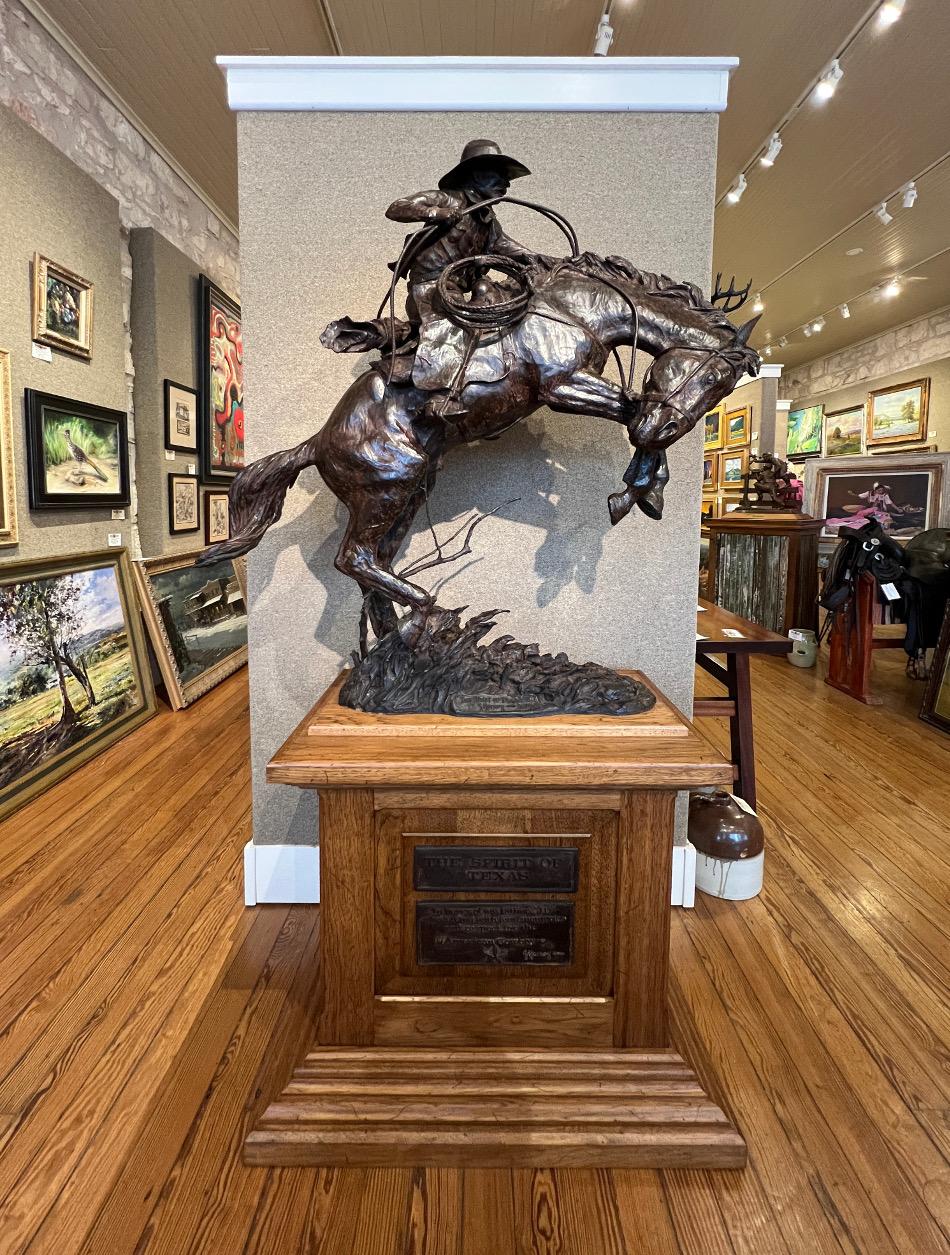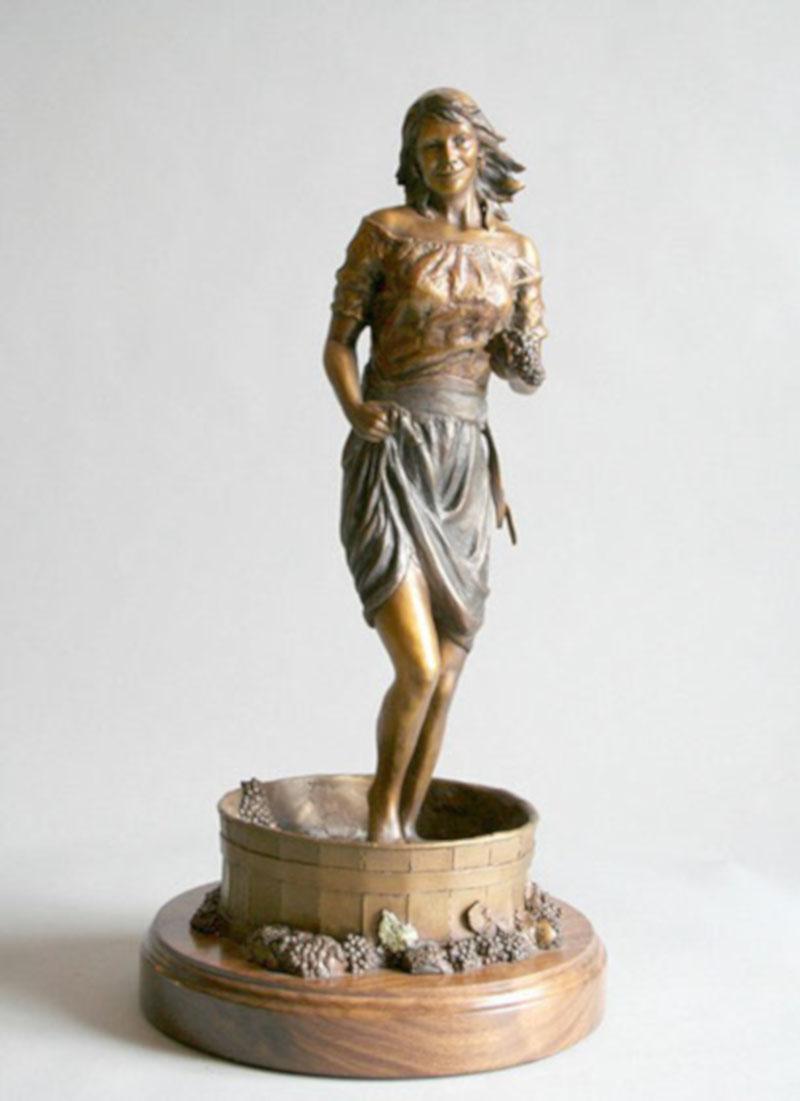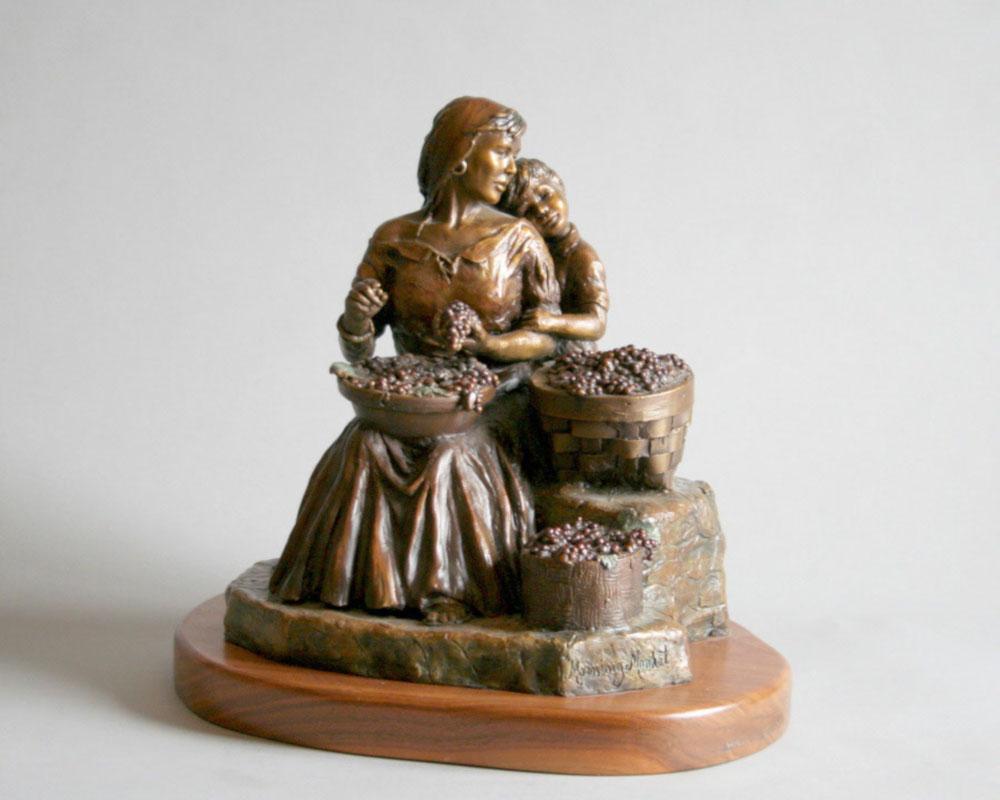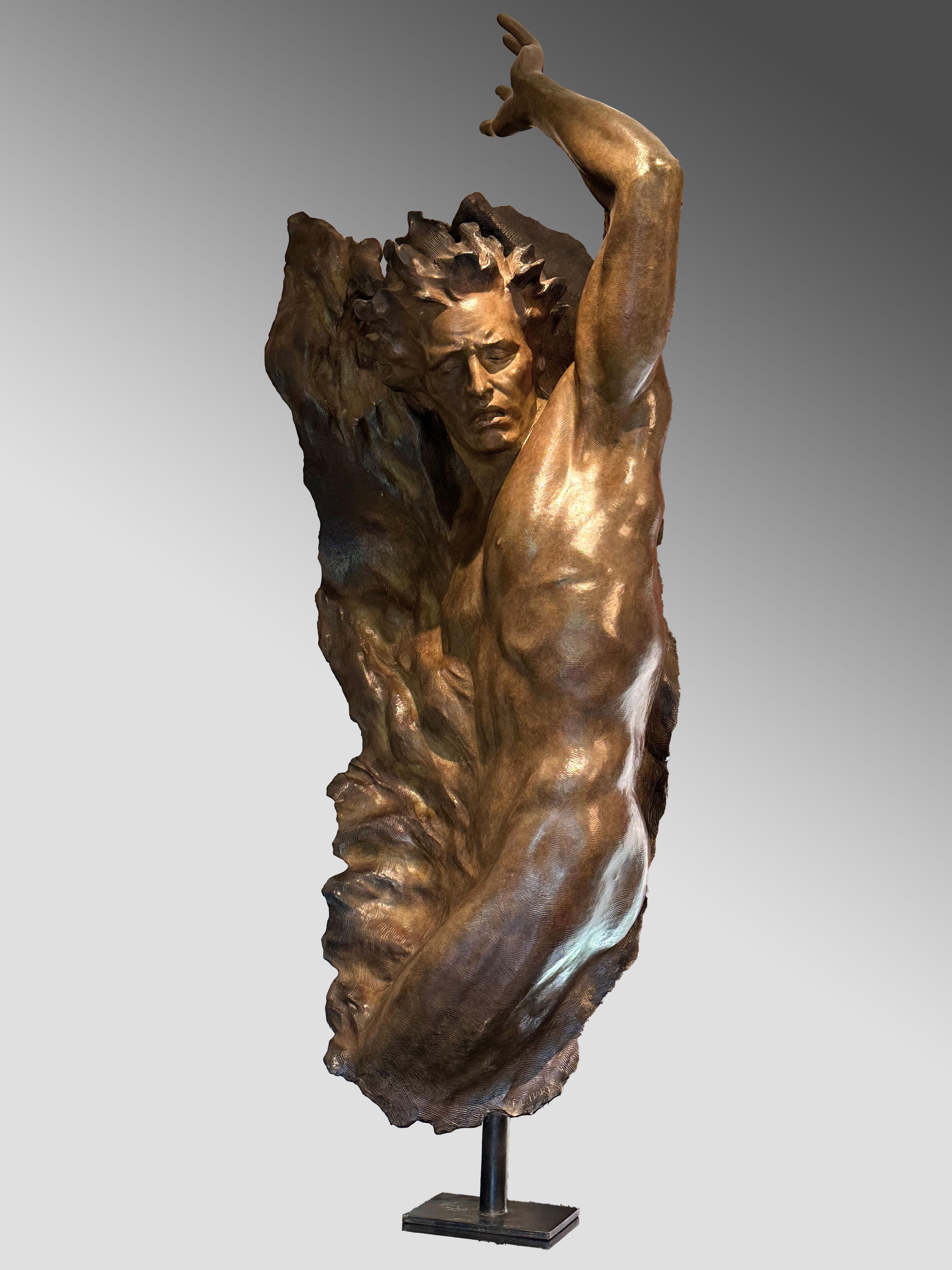Items Similar to “Ane d’Afrique” African Donkey bronze by Auguste Cain, Susse foundry
Want more images or videos?
Request additional images or videos from the seller
1 of 7
Auguste Cain“Ane d’Afrique” African Donkey bronze by Auguste Cain, Susse foundry 1860
1860
About the Item
Charming little bronze by the great animal sculptor Auguste-Nicolas Cain, signed A.Cain on the side, inscribed Ane d’Afrique (Donkey from Africa) and Susse Fres on the terrace. The donkey is represented loaded with its woven baskets in a vivid attitude.
Auguste Nicolas Cain (1821-1894) , pupil of A. l. Rude was trainee of Barye’s atelier and become a recognized animal sculptor with monumental statues in official places.
- Creator:Auguste Cain (1822-1894, French)
- Creation Year:1860
- Dimensions:Height: 5.91 in (15 cm)Width: 6.3 in (16 cm)Depth: 2.76 in (7 cm)
- Medium:
- Movement & Style:
- Period:
- Condition:
- Gallery Location:PARIS, FR
- Reference Number:1stDibs: LU2622212859552
About the Seller
No Reviews Yet
Vetted Seller
These experienced sellers undergo a comprehensive evaluation by our team of in-house experts.
Established in 1978
1stDibs seller since 2023
- ShippingRetrieving quote...Ships From: PARIS, France
- Return PolicyA return for this item may be initiated within 14 days of delivery.
More From This SellerView All
- « Titian Painter » Bronze Portrait lost wax cast, by W. Seib , AustrianLocated in PARIS, FRThe Painter Titian in his maturity. In left hand, his palette. Posture in majesty of this genial painter born in Poeve, in 1488 and dead in .Venice in 1575. Rare Bronze, lost wax c...Category
Early 20th Century Impressionist Figurative Sculptures
MaterialsMarble, Bronze
- “Knife Wrestlers”, After The Statue By J. P. Molin, Stockholm 1867Located in PARIS, FRRare and imposing reduction of the famous statue of JP Molin, inaugurated in 1867 in front of the National Museum of Stockholm. This version in black enamelled stoneware was produced...Category
1860s Academic Figurative Sculptures
MaterialsSandstone
- Ariane on Panther, Statue Alabaster, after J. H. Dannecker, end 19th cent.Located in PARIS, FR“Ariane on Panther” is the most worldwide known work of the German sculptor Johann Heinrich Dannecker, born 1758 and died 1841 in Stuttgart , pupil of Pajou and Canova. The original ...Category
1890s Academic Figurative Sculptures
MaterialsAlabaster
- Window’s Light in a Pink Interior - Wilhelm Henriksen (1880-1964) Danish schoolLocated in PARIS, FRPink interior illuminated by a White window", signed by Wm. Henriksen. Early 20th century A view from the Wm. Henriksen' best period, in which the precision of the line contributes to the vibration of light, so precious to the Danish interior...Category
Early 20th Century Impressionist Interior Paintings
MaterialsOil
- “Diana the Huntress” bronze after J. A. Houdon , France circa 1870By Jean-Antoine HoudonLocated in PARIS, FRBeautiful reduction of the famous marble masterpiece by J.A. Houdon, exhibited at the Goulbekian Foundation in Lisbon. The cast bronze, probably from NapoleonIII period, is heavy and...Category
1860s Academic Nude Sculptures
MaterialsBronze
- “The Four Seasons of Life” Set of large wall reliefs Bisque Royal CopenhagenBy Bertel ThorvaldsenLocated in PARIS, FRA rare complete set of “Four seasons of life” in Bisque porcelain, in an outstanding diameter 34cm without frame and 46 cm framed. After Bertil Thorvaldsen’ marble médaillons...Category
1860s Academic Sculptures
MaterialsPorcelain
You May Also Like
- " THE SPIRIT OF TEXAS " HUGE, 81" TALL BRONZE BUCKING BRONCO COWBOY WESTERNBy G. HarveyLocated in San Antonio, TXG. Harvey (Gerald Harvey Jones) (1933-2017) San Antonio, Austin, and Fredericksburg Artist Image Size: 81 Inches Tall Medium: Bronze Sculpture Dated 2006 "The Spirit Of Texas" Bucking Bronco & Rider They are very scarce. I only know about 2 others that have even come up for sale in the last 10 years or so. Please not the dedication on the wooden base of the sculpture. There is one on Gerald Harvey Jones (G. Harvey) tombstone in the Texas State Cemetery in Austin, Texas. Western, Cowboy, Horse, Bronc, Bronco Riata, Rodeo G. Harvey (Gerald Harvey Jones) (1933-2017) Known for paintings closely linked in mood and subject matter to Edouard Cortes [1882-1962], G Harvey creates romanticized street scenes of turn of the century towns in America. Rain slick streets reflect urban lights, and the weather is obviously cold. He grew up in the rugged hills north of San Antonio, Texas from where herds of longhorn cattle were once driven up dusty trails to the Kansas railheads. His grandfather was a trail boss at 18 and helped create an American legend for his grandson. So the American West is not only the artist's inspiration but his birthright. Harvey's early interest in sketching and drawing slowly evolved into a passion for painting in oils. After graduating cum laude from North Texas State University, Harvey took a position with the University of Texas in Austin, but he soon realized that weekends and nights at the easel did not satisfy his love of painting. He abandoned the security of a full-time job in 1963 and threw his total energy into a fine art career. Harvey paints the spirit of America from its western hills and prairies to the commerce of its great cities. His original paintings and bronze sculptures are in the collections of major corporations, prestigious museums, the United States government, American presidents, governors, foreign leader and captains of industry. The Smithsonian Institution chose Harvey to paint The Smithsonian Dream, commemorating its 150th Anniversary. The Christmas Pageant of Peace commissioned Harvey to create a painting celebrating this national event. He has been the recipient of innumerable awards and the subject of three books. G. Harvey lived in Fredericksburg, Texas, with his wife Pat in a 150-year-old stone home built by German settlers. His studio and residence are nestled within the Historic District of Fredericksburg. It is obligation of fine artists to present us with more than pretty pictures. They must also make us feel. Among the western painters of today, there is none more capable of accomplishing this than G. Harvey. In his paintings, the viewer into only sees the physical elements of his subject, but also senses the mood that surrounds them. It is a remarkable aspect of fine art, which few artists are able to master. Gerald Harvey Jones was born in San Antonio, Texas, in 1933. His grandfather was a cowboy during the trail-driving era when legends grew up along the dusty trails north from Texas. Family stories of wild cattle and tough men were absorbed by a wide-eyed boy and became the genesis of G. Harvey's art. A graduate in fine arts at North Texas State University, Harvey taught full-time and painted nights and weekends for several years. It was through painting that he found his greatest satisfaction, and his native central Texas hill country provided the inspiration for most of his earliest work. With the development of his talent and the growth of his following, Harvey began to expand his artistic horizons. He left teaching and concentrated on a career in fine art. He sought the essence that is Texas and found it not only along the banks of the Guadalupe, but in cow camps west of the Pecos, and in the shadows of tall buildings in big Texas cities. The streets of Dallas once echoed with the sound of horse hooves and the jingle of spurs. Historic photographs reveal what it looked like, but only an artist like Harvey can enable a viewer to experience the mood and flavor or the time. Contemporary western art has too often centered on the literal representations from its roots in illustrations. Artists like G. Harvey take us a step further, to the subjective impressions that are unique to each great talent and which constitutes something special and basic to fine art expression. Harvey was a soft-spoken and unassuming man who cared deeply about what he painted without becoming maudlin or melodramatic. We sense there is more in each Harvey painting than just that which is confined to the canvas. Resources include: The American West: Legendary Artists of the Frontier, Dr. Rick Stewart, Hawthorne Publishing Company, 1986 Artist G. Harvey grew up in the rugged hills north of San Antonio, Texas from where herds of longhorn cattle were once driven up dusty trails to the Kansas railheads. His grandfather was a trail boss at 18 and helped create an American legend. The American West is not only the artist's inspiration but his birthright. Harvey's early interest in sketching and drawing slowly evolved into a passion for painting in oils. After graduation cum laude from North Texas State University, Harvey took a position with the University of Texas in Austin, but he soon realized that weekends and nights at the easel did not satisfy his love of painting. He abandoned the security of a full-time job in 1963 and threw his total energy into a fine art career. Two years as a struggling artist followed, but 1965 brought acclaim for the artist's first prestigious show, The Grand National exhibition in New York, and the American Artists' Professional League presented him with their New Master's Award. President Lyndon Johnson discovered his fellow Texan's talent, became a Harvey collector and introduced John Connally to the artist's work. Connally was enthusiastic about Harvey's art, and, on one occasion, he presented a G. Harvey original to each governor of Mexico's four northern states. Harvey paints the spirit of America from its western hills and prairies to the commerce of its great cities. His original paintings and bronze sculptures are in the collections of major corporations, prestigious museums, the United States government, American presidents, governors, foreign leader and captains of industry. The Smithsonian Institution chose Harvey to paint The Smithsonian Dream commemorating its 150th Anniversary. The Christmas Pageant of Peace commissioned Harvey to create a painting celebrating this national event. He has been the recipient of innumerable awards and the subject of three books. Through his art, our history lives. Gerald Harvey Jones, better known as G. Harvey, grew up in the Texas Hill Country listening to his father and grandfather tell stories about ranch life, frontier days in Texas, and driving cattle across the Red River. Early in his career, he began to draw inspiration from that collective memory for paintings that would eventually earn him the reputation as one of America's most recognized and successful artists. His art is rooted in the scenic beauty of the land he grew up in and the staunch independence of the people who live there. He says, "My paintings have never been literal representations. They are part first-hand experience, and part dreams generated by those early stories I heard. They are a product of every place I have been, everything I have ever seen and heard." G. Harvey graduated from North Texas State University. He taught in Austin, but continued to study art in his spare time, eventually devoting full time to his painting. The year 1965 was a turning point when he won the prestigious New Masters Award in the American Artist Professional League Grand National Exhibition in New York. It is often said that in viewing a work of art, one is granted a unique look into the thoughts and expressions of values that give meaning to the artist work. Nowhere does this ring truer than the art of G. Harvey. Though Harvey has had nearly two decades of sell-out shows, an outstanding honor came with a series of one-man shows in Washington, D.C. in 1991. The first was at the National Archives featuring his paintings of the Civil War era, then a selection of paintings of notable Washington landmarks was exhibited at the Treasury Department, culminating in a one-man show of 35 paintings at the Smithsonian Institution during their exhibition of The All-American Horse. His work was featured in Gilcrease Museum exhibitions from 1992-1997. In 1987 his alma matter...Category
Early 2000s Impressionist Figurative Sculptures
MaterialsBronze
- "WINE DANCE" WOMAN FIGURELocated in San Antonio, TXScy Caroselli Colorado Artist Image Size: 25 inches tall Medium: Bronze "Wine Dance" Scy has been surrounded by fine art throughout her entire life. She grew up beside the easel and ...Category
2010s Impressionist Figurative Sculptures
MaterialsBronze
- "MORNING MARKET" WOMAN SITTING WITH CHILDBy ScyLocated in San Antonio, TXScy Caroselli Colorado Artist Image Size: 11 x 10 x 9 Medium: Bronze "Morning Market" Scy has been surrounded by fine art throughout her entire life. She grew up beside the easel and sculpting stand...Category
2010s Impressionist Figurative Sculptures
MaterialsBronze
- "Ex Nihilo Figure 7", Frederick Hart, Bronze Sculpture, Figurative, TraditionalBy Frederick HartLocated in Dallas, TXDon't miss this opportunity to own a piece of history! Ex Nihilo Figure 7, a full-scale plaster from the final stone sculpture of Ex Nihilo, commissioned as part of the Creation Scul...Category
Early 2000s American Impressionist Figurative Sculptures
MaterialsBronze
- "Ex Nihilo Figure 4", Frederick Hart, Bronze Sculpture, Figurative ManBy Frederick HartLocated in Dallas, TXDon't miss this opportunity to own a piece of history! Ex Nihilo Figure 4, a full-scale plaster from the final stone sculpture of Ex Nihilo, commissioned as part of the Creation Scul...Category
Early 2000s American Impressionist Figurative Sculptures
MaterialsBronze
- The Hundredth MessBy Jane DeDeckerLocated in Greenwich, CTEdition of 31 Jane DeDecker’s energetic and dynamic bronze sculptures serve as a reflection of her own life experiences and those of her closely-knit family. Her twelve nieces and ne...Category
Early 2000s American Impressionist Figurative Sculptures
MaterialsBronze





